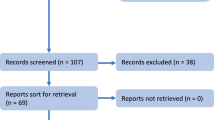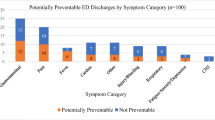Abstract
Purpose
The aim of this review was to explore the range and prevalence of cancer treatment or disease-related symptoms in the emergency department and their associated outcomes.
Methods
A systematic review examined studies cited in Medline, Embase, PsycINFO, and CINAHL published from 1980 to July 2011. Eligible studies measured emergency department visits for symptom assessment in adult oncology patients. Two reviewers independently screened citations and double data extraction was used. Descriptive analysis was conducted.
Results
Of 1,298 citations, six prospective and 12 retrospective descriptive studies were included. Of these, eight focused on multiple symptoms and 10 targeted specific symptoms. The studies were published between 1995 and 2011, conducted in seven countries, and had a median sample size of 143 (range 9–27,644). Of the 28 symptoms reported, the most common were febrile neutropenia, infection, pain, fever, and dyspnea. Definitions provided for individual symptoms were inconsistent. Of 16 studies reporting admission rates, emergency visits resulted in hospital admissions 58 % (median) of the time in multi-symptom studies (range 31 % to 100 %) and 100 % (median) of the time in targeted symptoms studies (range 39 % to 100 %). Of 11 studies reporting mortality rates, 13 % (median) of emergency visits captured in multi-symptom studies (range 1 % to 56 %) and 20 % (median) of visits in targeted symptoms studies (range 4 % to 67 %) resulted in death.
Conclusions
Individuals with cancer present to emergency departments with a myriad of symptoms. Over half of emergency department visits resulted in hospital admissions. Few symptoms were defined adequately to compare data across studies, thereby revealing an important gap in cancer symptom reporting.

Similar content being viewed by others
References
Díaz-Couselo FA, O'Connor JM, Nervo A, Tossen G, Guercovich A, Puparelli C, Coronado C, Costanzo V, Zylberman M (2004) Non-scheduled consultation in oncologic patients. How many of them are true emergencies? An observational prospective study. Support Care Cancer 12:274–277
Girmenia C, Alimena G, Latagliata R, Morano SG, Celesti F, Coppola L (1999) Out-patient management of acute myeloid leukemia after consolidation chemotherapy. Role of a hematologic emergency unit. Haematologica 84:814–819
Geraci JM, Tsang W, Valdres RV, Escalante CP (2006) Progressive disease in patients with cancer presenting to an emergency room with acute symptoms predicts short-term mortality. Support Care Cancer 14:1038–1045
Uramoto H, Iwashige A, Kagami S, Tsukada J (2007) Prediction of emergency hospitalization of outpatients receiving cancer chemotherapy. Anticancer Res 27:1133–1136
Swenson KK, Rose MA, Ritz L, Murray CL, Adlis SA (1995) Recognition and evaluation of oncology-related symptoms in the emergency department. Ann Emerg Med 26:12–17
Kerrouault E, Denis N, Le Conte P, Dabouis G (2007) Improving organization of care could reduce referrals of cancer patients to the emergency department. Prospective analysis of 123 patients. Presse Med 36:1557–1562
Mayer DK, Travers D, Wyss A, Leak A, Waller A (2011) Why do patients with cancer visit emergency departments? Results of a 2008 population study in North Carolina. J Clin Oncol 29(19):2683–2688
Livingston P, Craike M, Considine J (2011) Unplanned presentations to emergency departments due to chemotherapy induced complications: opportunities for improving service delivery. Aust Emerg Nurs J 14:62–68
King V, Vaze AA, Moskowitz CS, Smith LJ, Ginsberg MS (2008) D-dimer assay to exclude pulmonary embolism in high-risk oncologic population: correlation with CT pulmonary angiography in an urgent care setting. Radiology 247:854–861
Kung C, Liu B, Ng S, Lee T, Cheng Y, Chen M, Ko S (2008) Transcatheter arterial embolization in the emergency department for hemodynamic instability due to ruptured hepatocellular carcinoma: analysis of 167 cases. AJRN 191:W231–W239
Escalante CP, Manzullo EF, Lam TP, Ensor JE, Valdres RU, Wang XS (2008) Fatigue and its risk factors in cancer patients who seek emergency care. J Pain Symptom Manage 36:358–366
Escalante CP, Martin CG, Elting LS, Cantor SB, Harle TS, Price KJ et al (1996) Dyspnea in cancer patients. Etiology, resource utilization, and survival-implications in a managed care world. Cancer 78:1314–1319
Nirenberg A, Mulhearn L, Lin S, Larson E (2004) Emergency department waiting times for patients with cancer with febrile neutropenia: a pilot study. Oncol Nurs Forum 31:711–715
Tsai S, Liu L, Tang S, Chen J, Chen M (2010) Cancer pain as the presenting problem in emergency departments: incidence and related factors. Support Care Cancer 18:57–65
Perrone J, Hollander JE, Datner EM (2004) Emergency department evaluation of patients with fever and chemotherapy-induced neutropenia. J Emerg Med 27:115–119
Courtney DM, Aldeen AZ, Gorman SM, Handler JA, Trifilio SM, Parada JP (2007) Cancer-associated neutropenic fever: clinical outcome and economic costs of emergency department care. Oncologist 12:1019–1026
Andre S, Taboulet P, Elie C, Milpied N, Nahon M, Kierzek G et al (2010) Febrile neutropenia in French emergency departments: results of a prospective multicentre survey. Crit Care 14:R68
Hsu TF, Huang HH, Yen DH, Kao WF, Chen JD, Wang LM et al (2004) ED presentation of neutropenic enterocolitis in adult patients with acute leukemia. Am J Emerg Med 22:276–279
Canadian Cancer Society (2011) Canadian Cancer Society’s Steering Committee on Cancer Statistics: Canadian Cancer Statistics 2011. http://www.cancer.ca/Canada-wide/About%20cancer/Cancer%20statistics/PowerPoint%20slides.aspx?sc_lang=en. Accessed 15 May 2011
Health Canada (2009) Adverse reaction information. http://www.hc-sc.gc.ca/dhp-mps/medeff/advers-react-neg/index-eng.php. Accessed 15 May 2011
Yamagishi A, Morita T, Miyashita M, Kimura F (2009) Symptom prevalence and longitudinal follow-up in cancer outpatients receiving chemotherapy. J Pain Symptom Manage 37:823–830
Haiderali A, Menditto L, Good M, Teitelbaum A, Wegner J (2011) Impact of daily functioning and indirect/direct costs associated with chemotherapy-induced nausea and vomiting (CINV) in a US population. Support Care Cancer 19:843–851
Wagner LI, Cella D (2004) Fatigue and cancer: causes, prevalence and treatment approaches. Br J Cancer 91:822–828
Barbera L, Seow H, Howell D, Sutradhar R, Earle C, Liu Y et al (2010) Symptom burden and performance status in a population-based cohort of ambulatory cancer patients. Cancer 116:5767–5776
Brydoy M, Oldenburg J, Klepp O, Bremnes RM, Wist EA, Wentzel-Larsen T et al (2009) Observational study of prevalence of long-term Raynaud-like phenomena and neurological side effects in testicular cancer survivors. J Natl Cancer Inst 101(24):1682–1695
Henry DH, Viswanathan HN, Elkin EP, Traina S, Wade S, Cella D (2008) Symptoms and treatment burden associated with cancer treatment: results from a cross-sectional national survey in the U.S. Support Care in. Cancer 16(7):791–801
Behl D, Hendrickson AW, Moynihan TJ (2010) Oncologic emergencies. Crit Care Clin 26:181–205
Chan B, Schull M, Schultz S (2001) Emergency department services in Ontario. Institute for Clinical Evaluative Sciences (ISBN 0-9686318-9-4) 1-54
Li G, Lau JT, McCarthy ML, Schull MJ, Vermeulen M, Kelen GD (2007) Emergency department utilization in the United States and Ontario, Canada. Acad Emerg Med 14:582–584
McCusker J, Roberge D, Levesque JF, Ciampi A, Vadeboncoeur A, Larouche D et al (2010) Emergency department visits and primary care among adults with chronic conditions. Med Care 48:972–980
Godfrey C, Harrison M (2010) Systematic review resource package. The Joanna Briggs Institute method for systematic review research quick reference guide. Queen’s Joanna Briggs Collaboration, Kingston
Stone PW (2002) Popping the (PICO) question in research and evidence-based practice. Appl Nurs Res 16:197–198
Public Health Resource Unit (2004) Critical Appraisal Skills Programme (CASP) Making sense of evidence: 12 questions to help you make sense of a cohort study. http://prhu.nhs.uk/pages/PHD/CASP.htm. Accessed 27 January 2011
Peelan L, Klein M, Schlobach S, de Keizer N, Peek N (2007) Analyzing differences in operational disease definitions using o.lntological modeling. In: Bellazzi R, Abu-Hanna A, Hunter J (eds) AIME. Springer, Berlin, pp 297–302
Stacey D, Bakker D, Green E, Zanchetta M, Conlon M (2007) Ambulatory oncology nursing telephone services: a provincial survey. Can Oncol Nurs J 17:186, e1-5
Wilson R, Hubert J (2002) Resurfacing the care in nursing by telephone: lessons from ambulatory oncology. Nurs Outlook 50:160–164
Hoot NR, Aronsky D (2008) Systematic review of emergency department crowding: causes, effects, and solutions. Ann Emerg Med 52:126–136
Moore S (2007) Managing treatment side effects in advanced breast cancer. Semin Oncol Nurs 23:S23–S30
Niska R, Bhuiya F, Xu J (2010) National hospital ambulatory medical care survey: 2007 Emergency department summary. U.S Department of Health and Human Services, Centers for Disease Control and Prevention. National Center for Health Statistics (DHHS Publication No. (PHS) 2010-1250 CS213803) 1:32
Nadeem Ahmed M, Muyot MM, Begum S, Smith P, Little C, Windemuller FJ (2010) Antibiotic prescription pattern for viral respiratory illness in emergency room and ambulatory care settings. Clin Pediatr 49:542–547
Chan WL, Goh HK, Vasu A, Lim BL, Seow E (2011) Experience of a screening centre for influenza A/H1N1: the first 50 days. Emerg Med J 28:18–24
Tomas J, Lelievre F, Bercelli P, Glanddier P, Fanello S, Tuffreau F et al (2011) Hospital admissions related to influenza in France during the 2006/2007 epidemic. Rev Epidemiol Sante Publique 59:159–167
Quach C, Moore D, Ducharme F, Chalut D (2011) Do pediatric emergency departments pose a risk of infection? BMC Pediatr 11:2
National Comprehensive Cancer Network. (2008). NCCN Clinical practice guidelines in oncology: prevention and treatment of cancer-related infections. Version 1. Retrieved from: http://www.nccn.org/professionals/physician_gls/f_guidelines.asp
The Joanna Briggs Institute (2011) Joanna Briggs Institute Reviewers’ Manual. The Joanna Briggs Institute, Adelaide
Acknowledgments
This study received funding in part from the Canadian Partnership Against Cancer. We would like to acknowledge and thank Val Angus for her assistance with editing the manuscript.
Conflict of interest
There are no conflicts of interest for any of the authors. The authors have copies of all studies included in this systematic review and full control over data extracted from these studies. We agree to allow the journal editors to review the data if requested.
Author information
Authors and Affiliations
Corresponding author
Rights and permissions
About this article
Cite this article
Vandyk, A.D., Harrison, M.B., Macartney, G. et al. Emergency department visits for symptoms experienced by oncology patients: a systematic review. Support Care Cancer 20, 1589–1599 (2012). https://doi.org/10.1007/s00520-012-1459-y
Received:
Accepted:
Published:
Issue Date:
DOI: https://doi.org/10.1007/s00520-012-1459-y




